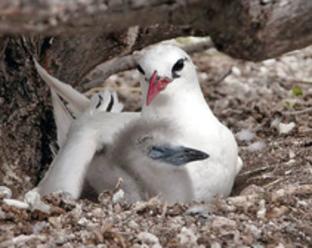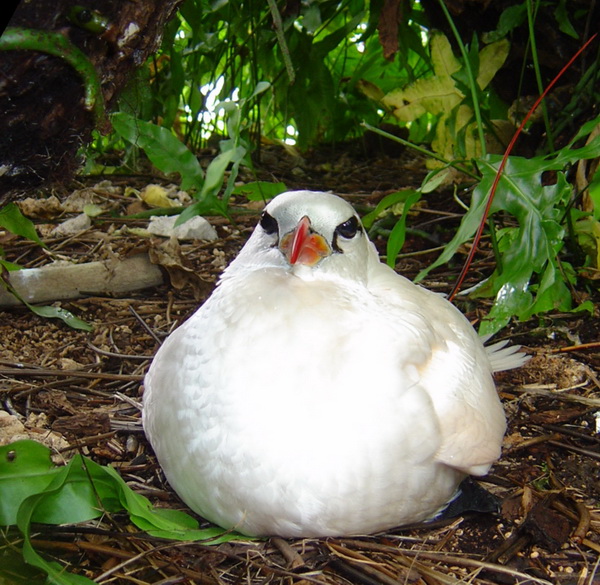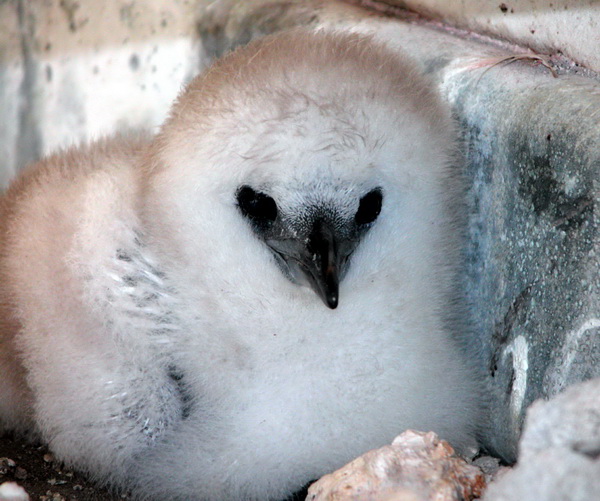Published in the Ocean Watch column, Honolulu Star-Advertiser © Susan Scott
April 18, 2011
While hiking with friends at Kaena Point last week, I heard, in the cliffs above, goats fighting. Or donkeys in distress. Or mongooses mating. Or cats in heat.
I knew it was none of those, though, because I’ve had similar racket blasted directly into my ears from just inches away. The creatures making those god-awful sounds are among the world’s most elegant marine animals: tropicbirds.

©2011 Susan Scott
A red-tailed tropicbird protects a chick under its wing on Tern Island.
Tropicbirds are aptly named because they breed and fish almost exclusively in the tropics and subtropics. Two species nest in Hawaii, the white-tailed and red-tailed. The third, the red-billed tropic bird, nests on islands in the Sea of Cortez (Gulf of California) and in the Galapagos Islands, and is a rare visitor to Hawaii.
White-tailed tropicbirds nest in holes on cliff faces, and it is this species we hear calling above Kaena Point (and other places). The birds call constantly when flying near their nest sites, perhaps saying, “Honey, I’m home!” to their chick or egg-brooding mate.
Whenever I hike to Kaena Point, I nearly always hear those unmistakable raspy calls. I rarely see the birds, though, because their loud cries bounce off the rocks, making the birds seem closer than they are. Also, white-tailed tropicbirds are fast, using the wind to help them zoom and swoop along the rock faces as they home in on their nests.
 ©2011 Susan Scott
©2011 Susan Scott
Sailors of old called tropicbirds bosun birds because their call at sea reminded the men of a bosun’s whistle, the old-time system of signaling orders to the crew. This gives us a clue as to what sailors thought of that call to work. In reading about tropicbirds, I found their sounds described as rasping calls, peevish snarls, piercing screams, unpleasant cries, harsh squawks and sharp barks.
Tropicbirds’ raucous sounds contrast sharply with their appearance. All three species have two conspicuous tail feathers nearly as long as their bodies. These feathers, called streamers, are for show only, presumably to attract mates. With their mostly white bodies and classy tail feathers, tropicbirds look like they’re in white-tie-and-tails and ready to dance on air.
And they do. Tropicbirds are famous for their exuberant courtship displays, flying backward, in circles or performing aerial zigzags. One ardent white-tailed tropicbird in California fell for a model glider, calling excitedly and flying close enough to drag its lovely steamers along the fuselage. When the yellow glider sat on the ground, the bird even tried to mate with it.
Tropicbird chicks hatch covered with fluffy gray down. Rather than sitting on its chick like most seabirds, the tropicbird parent warms and protects its offspring by draping a protective wing over the chick’s back.
On Tern Island I once had the job of fastening ID bands on the legs of red-tailed tropicbird chicks, adult size but not yet able to fly. For my first attempt, I crawled under a bush (red-tails are ground-nesters) and reached for the quiet youngster.

In a flash that sweet-looking chick became the seabird from hell, ripping a hole in my thumb, puking putrid fish on my hand and screeching like a banshee in my ear.
Over time I got better at banding tropicbirds and came to love these spirited birds that dress to the nines and hug their kids. Even when they sound like goats.